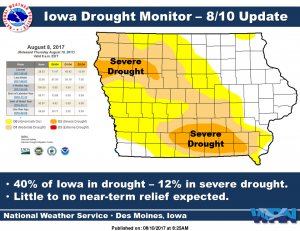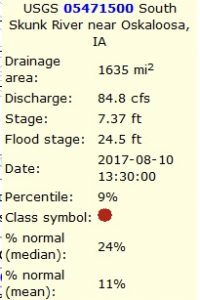Mahaska County Agriculture Dealing With Severe Drought Conditions
Oskaloosa, Iowa – Members of the agricultural community gathered on Wednesday evening to hear experts from the ISU Extension Office, and others, talk about how to mitigate losses from the drought.
The U.S. Drought Monitor released their latest information, showing that Mahaska County continues to be in the D2 category, or Severe Drought.
Just years after being at all-time record high levels, the South Skunk River near Oskaloosa is now near record lows. It is ranked at 9% of its normal flow, which puts the river level into the lowest level ever measured for that day for all years on record.
Mahaska County Farmer Mark Jackson spoke to Oskaloosa News last week about how he and his farming operation are dealing with the drought.
Jackson’s farm is 10 miles northeast of Oskaloosa, “I literally have had only one inch of rain since the third week in May. So here we are almost nine weeks later, my crop which typically takes an inch a week when it comes to a farm crop. So we’re working on, you might say, modern agriculturists techniques today.”
Jackson spoke about modern hybrids that help crops resist some drought, but rain is still needed at critical times to help the pods produce, which, in turn, need rain during August to help fill those pods. “I think approximately 2012, so five years ago, we had an almost similar scenario where it quit raining somewhere right after we planted, around mid-May. And next thing we know, it’s two months later, and we’ve had virtually no rain. But the root systems of the modern hybrids, which have been researched out in the fields as well as in the laboratories, help resist hot weather and they are able to root down. So rooting systems of corn can go six, eight feet deep and follow the water table. And we did have a good water table going into the spring, so I think that’s a lot of it.”
We asked Jackson if he could tell if the yield was being impacted. “There’s definitely areas, percentages of fields, and all fields are not the same. Soil types are varied throughout a field, so the tighter soils are showing firing, that the plant is shutting down, it’s firing, it’s not getting moisture, and it is going backward a percentage. So yes, right now I predict a half a crop. Our typical yield would be 160 some bushels, that would be an average. I think last year 162 sounds like an average. My farm average last year was 200, just to give you an idea of where I am right now. So I am not optimistic by any means about having a bumper crop, or even an average crop at this point. It’s just a matter of maintaining what I have.”
When it comes to modern agriculture, it’s the hybrids being used that help farmers make the most of the bad years. 2017 is turning out to be one of those years, and Jackson appreciates the advancements being made. “Yes, modern agriculture is the key right now to our success of having a crop, that at least we can say we still have a crop. Because first of all, it’s not my grandfather’s agriculture anymore, in so much as I probably plant my crop at least a month earlier than what my grandfather did, partly because he didn’t have the equipment nor the time to get out there in a timely fashion. But I’m able to no-till using technologies, GPS, things like that, where I place fertilizers precisely within a narrow band, and I don’t have to use all kinds of high impact chemicals, such as that would help stunt the plant as it would have to grow through it. So yeah, modern agriculture is part of the key to our success today.”
Time is running out for area farmers to make the most of this year’s crop. “If it doesn’t rain between now and harvest I would hate to think what the corn crop would be. The soy bean crop really, the fill period is in August, so we still have a little more time. The clock is ticking quickly on the corn. Soybeans have a little more drought tolerance. They’re a tap root versus a mass root, which is the difference between soybean and corn.”
When looking at other parts of Iowa, some parts of south central Iowa have faced the worst drought. We asked Jackson if he gets frustrated watching those rains fall in other places.
“Well frustration really doesn’t fit well in a farmer’s vocabulary, and I’ve farmed for over four decades, so after a while, it is what it is. And I’ve been fortunate, the 2012 event was a 75% crop for me, but prior to that, we had 20 years of good crops. 2016 was the best corn and soybean crop that I had ever raised in my entire farming career. Kudos to that, but it took me 43 years to do it,” said Jackson.












